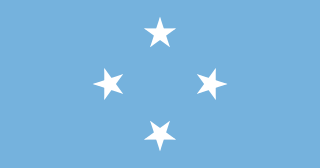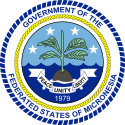
The Federated States of Micronesia is an island country in Oceania. It consists of four states – from west to east, Yap, Chuuk, Pohnpei and Kosrae – that are spread across the western Pacific. Together, the states comprise around 607 islands that cover a longitudinal distance of almost 2,700 km (1,678 mi) just north of the equator. They lie northeast of Indonesia and Papua New Guinea, south of Guam and the Marianas, west of Nauru and the Marshall Islands, east of Palau and the Philippines, about 2,900 km (1,802 mi) north of eastern Australia, 3,400 km (2,133 mi) southeast of Japan, and some 4,000 km (2,485 mi) southwest of the main islands of the Hawaiian Islands.

The politics of the Federated States of Micronesia (FSM) takes place in a framework of a federal assembly-independent representative democratic republic. The President of the Federated States of Micronesia is both head of state and head of government. Executive power is exercised by the president and his cabinet, while legislative power is vested in both the president and the Congress. The judiciary is independent of the executive and the legislature.

Joseph John "Joe" Urusemal is a Micronesian political figure who served as the sixth President of the Federated States of Micronesia from 2003 until 2007.

John Richard Haglelgam was the second President of the Federated States of Micronesia.

The Congress of the Federated States of Micronesia has 14 non-partisan members: ten members elected for a two-year term in ten single-seat constituencies and four members elected for a four-year term, one from each state at-large.

Parliamentary elections were held in the Federated States of Micronesia on 6 March 2007, alongside a double referendum. Thirty-five candidates competed for the fourteen seats in Congress. As there were no political parties, all candidates ran as independents.

Parliamentary elections were held in the Federated States of Micronesia on 8 March 2005, alongside a three-part referendum. As no political parties existed, all 23 candidates for the 10 available seats in Congress ran as Independents.

The vice president of Federated States of Micronesia is the second highest position in Federated States of Micronesia. The vice president is elected by the Congress of the Federated States of Micronesia from among the at-large members for a four-year term. The vice president is also a part of the legislature. The annual salary of the vice president is set to US$70,000.

Parliamentary elections were held in the Federated States of Micronesia on 3 March 2009. As there were no political parties, all 21 candidates ran as independents. Three were returned unopposed.

The Constitution of the Federated States of Micronesia is the supreme law of the Federated States of Micronesia. It was adopted in 1979.

Parliamentary elections were held in the Federated States of Micronesia on 8 March 2011, alongside a three-part referendum. As there were no political parties, all 34 candidates ran as independents. For the first time in the country's history, two women ran for election, both in Chuuk State. However, neither was elected.

Parliamentary elections were held in the Federated States of Micronesia on 3 March 1987 alongside a referendum on having a four-year term of office for all members of Congress. All candidates for seats in Congress ran as independents, whilst the referendum proposal was rejected by voters.

Parliamentary elections were held in the Federated States of Micronesia on 4 March 1997, alongside a referendum on tax revenues. All candidates for seats in Congress ran as independents.

A referendum on the powers of the federal government to levy taxes on imports was held in the Federated States of Micronesia on 4 July 1995. Congress had adopted Public Law 8-135 on the matter, which would have altered article II of Chapter IX of the constitution. However, the move was vetoed by President Bailey Olter on 22 March. As a result, the referendum was held alongside by-elections for Congress. A three-quarter majority was required in three of the four states, but the proposal was rejected by voters.

A four-part referendum was held in the Federated States of Micronesia on 1 July 1999. Voters were asked whether a constitutional convention should be called, whether they approved of a proposal on the distribution of revenues from the country's exclusive economic zone (EEZ), whether the amount of tax revenues distributed to the states should rise from 50% to 70%, and whether states should be given exclusive ownership of their natural resources. The latter three had originally been planned to be held alongside the parliamentary elections in March, but were postponed due to a lack of funds to print the ballot papers.

A constitutional referendum was held in the Federated States of Micronesia on 27 August 2002. Voters were asked whether they approved of 14 separate amendments to the country's constitution. To be approved, the proposal required at least 75% of voters in at least three of the four states to vote in favour. Ultimately all 14 proposals were rejected, as none passed the 75% threshold in any state.

Parliamentary elections were held in the Federated States of Micronesia on 4 March 2003. As there were no political parties, all 28 candidates ran as independents. Four candidates were elected unopposed.

Parliamentary elections were held in the Federated States of Micronesia on 7 March 2017, alongside a referendum on allowing dual citizenship. Although the proposed constitutional amendment to allow dual citizenship was approved by a majority of voters, it did not pass the threshold of 75% voting in favour in at least three of the four states.

Parliamentary elections were held in the Federated States of Micronesia on 5 March 2019, alongside a referendum on calling a Constitutional Convention. All 14 seats in Congress were up for election, and all 13 incumbents standing for re-election were returned to Congress.

Parliamentary elections were held in the Federated States of Micronesia on 2 March 2021, to elect ten of the fourteen seats of the Congress of Micronesia for a two-year term. There are no political parties and all candidates stood as independents.





